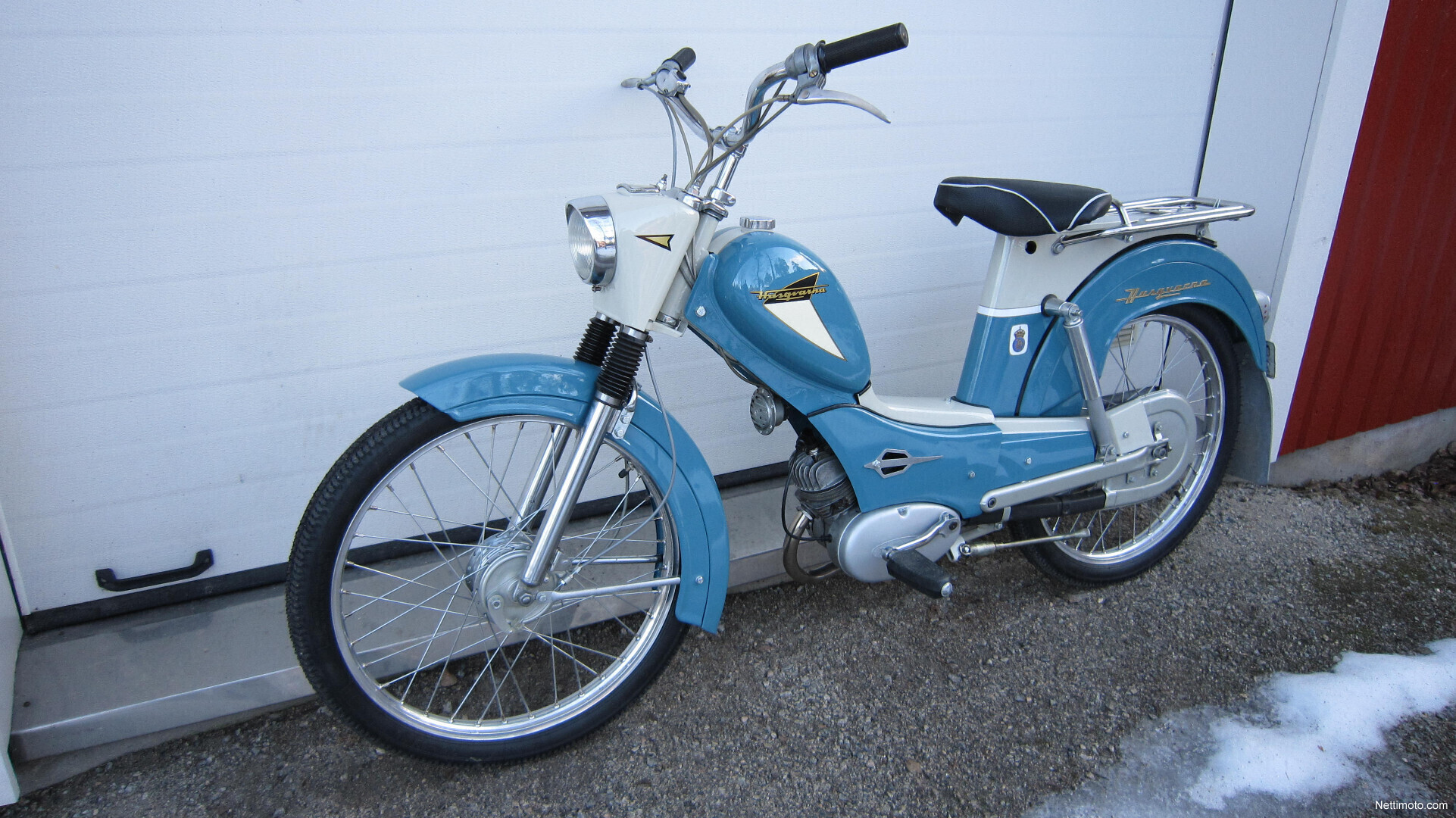Moped Husqvarna Roulette
MOPED, Husqvarna Roulette Luxury, 50cc. Black and cream colored. Spare part catalog and instruction manual included. Sold in existing condition for estate. Started and tested by auction company. Fully refurbished. A couple of scratches. Very good overall impression. Then, Husqvarna's in-house version was presented. A number of the factory’s moped models were sold during the 50s and in the beginning of the 60s. First out was the luxury machine Roulette, designed by the famous Swede Sixten Sason - a man who made his fame and fortune as a successful industrial designer. So, always roulette a look under 'Universal' trim if you are looking for a husqvarna that may fit other mopeds also. Also, English translations are in progress but yet ready. It might help to choose Swedish up right and sms roulette meldinger forslag use the Google translate button.
Find parts for Husqvarna scooters / mopeds. Please select model Husqvarna scooter / moped: Husqvarna 281 TURIST Parts. Husqvarna 31 STANDARD 120CC Parts. Husqvarna 32 SPORT Parts. Husqvarna 4012 Parts. Husqvarna ROULETTE 3752 STANDARD Parts. Husqvarna ROULETTE 3772 LYX Parts. Husqvarna ROULETTE 3811 Parts. Husqvarna ROULETTE 3822 Parts.
| Entré ticket. Ref 1 | Bjorkenas museum mopeds Text och bilder Björn Bellander. Bilder aktuella 2013, 2015 Official websiteBack Swedish version20 pages | since 060105 Updated 2020-06-16 ©Björn Bellander |
See also the following websites. Mopeds galleryMotorcyclesGallery motorcycles. |
| Husqvarna Novolette Husqvarna PopulärHusqvarna Roulette LyxZündapp CX 50Honda P50 Monark M51Monark M35 LutzKuli KreidlerRexSolexMustangFram-KingYamahaPantherVelmoDKWVictoriaOther mopedsLinks |
| Page 0 Created 131201 Back Bjorkenas museum
Links |
|
| Page 1 Skapad 131201 Husqvarna Novolette
|
|
| Page 2 Husqvarna Populär |
|
| Page 3 Husqvarna Roulette Lyx
|
|
| Page 4 Zündapp CX 50
Länkar |
|

| Page 5 Swedish version
Honda P50 |
|

| Page 6 Monark M51 1957
|
|
| Page 7 Monark M35 | Monark M35 1954 Motor ILO There were also the model no M36, M50, M55. It coul also have a Rex Pilot engine. |
| Page 8
|
|
| Page 9 Kuli
|
|
| Page 10 Kreidler Florette |
|
| Page 11 Rex Vicoped |
|
| Page 12 Velo Solex |
|
| Page 13 Mustang Mamba 1979
| Mustang Mamba 1970- 1985 Engine Zündapp 49 cc 1 ps.
|
| Page 14 Fram King Clipper
| Fram King Clipper 1964-1970 Tillverkare AB Josef Eriksson Uppsala Från 1958 Fram King Bolagen. Motor Victoria/DKW EM 50 49 cc 1 hk 3 växlar fotväxel
|
| Page 15 Yamaha FS 1 | Yamaha FS 1 Motor Yamaha, 49 cc 0,8 ps 4 gears changed with foot pedal. Swedish agent Hallman & Enequist Motor AB
|
Moped Husqvarna Roulette Videos
| Page 16 Panther
|
|
| Page 17 Velmo
|
|
| Page 18 DKW 115
DKW Hummel | DKW 115
|
| Page 19 Victoria Hummel |
|
| Page 20 Other mopeds
ABG |
|

| Other Cars MC museums in this website Back Museumlist Adalen car museum Arnolds_cars & odds ends Arvika car mc museum Assa car museum AUDI Ingolstadt Autoseum Autostadt Barnfind Halsingland Barnfind Katrineholm Brosarp Museistation Bjorkenas mopedmuseum Brooklands England Bugatti 2000 Bugatti 2018 BiancoRosso BMW Beaulieu England Bynanders Car MC Car sport museum Karlskrona Chaparral carmuseum Duxford England Dalén musem Eds Motorcycle museum Enoch Thulin Landskrona Falkoping MC Museum Foundries and mines Garage round in Halsingland Grangesberg Nostalgi Grafors Collection Grangesberg Locos Hannover air museum Hassleholm mil. vehicles Holmgren VW collection Haynes England Hjorted Mopedmuseum Harnosand carmuseum Huskvarna museum Ivar Car museum Hoting Koping car museum Krylbo-Norbergs rail Ladenburg My Vehicles Malmkoping mil. vehicle museum | Malmo Technical museum Mercedes Benz 2000 Mercedes Benz 2018 MC-Collection Sweden MC museum Hedemora Motala museum MotorTechnica Munktell museum Museum joerney 2018 My ArtGlas collection NSU 2018 Otto Walz 2018 Outbordmuseum Varb. Peugeot 2018 Porsche 2000 Porsche 2018 Rydaholms Car Museum Robot Museum Sweden Regnsjo, SAF cars Panzeranzer museum ScaniaVabis museum Sinsheim museum 2000 Sinsheim museum 2018 Skokloster car museum SSK Boxcar SSK-series Storvik Odds and Ends Svedino car & airplane Soderhamn Air Force Sparreholm museum Sagen Technical museum Surahammar MC Swedish Air force museum Swedish submarines Torsong MC museum Torsby Car MC museum Technical museum Helsinb Technical museum Stockholm Ullared carmuseum Volkswagen Volvo Industrial museum Ziegenhagen Other sites Military service Travels(in Swedish) My Heritage(in Swedish) Trainmuseum Sweden Vasteras Airmuseum Hagfors Industrimuseum Karlskrona Marina |
| Pictures from the following owners has been used in bjorns-story with the appropriate allowance: Reference 1: ©Björn Bellander bjorn.bellander(at)telia.com Reference 48: ©Collected from website Reference 49: ©Picture/text from Wikipedia | Website about Bjorkenas Moped museum 20 pages. © Copyright Björn Bellander 2006 |
Husqvarna is a Swedish manufacturer that produced weapons, motorcycles, and mopeds. They built their their first moped, the Novolette, in 1952. This first model was essentially a bicycle with a bolted-on 40cc engine. The engine was later enlarged to 44cc and fitted with a two speedgearbox as an option.
Moped Husqvarna Roulette Games
Sometime around 1956-57 came the second model, the Roulette, which got its name from the induction system via a rotary slide valve. It was difficult to increase the power significantly from 0.8 hp, but it was a reliable and very good-looking moped designed by the well-known designer Sixten Sason. It was available both as two and three speed (very rare) versions. Some other models followed, such as the Cornette and the scooter-moped Corona.
Husqvarna Roulette Moped
In 1963, Monark Crescent and Husqvarna formed MCB. Husqvarna manufactured all(?) engines for the different MCB models, like the recently developed E-engine. Some enthusiasts believe that 1962 was the last year for the 'real' Husqvarna mopeds, although the name lived for some years on.